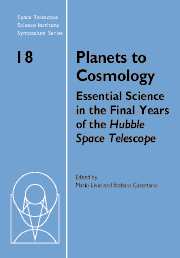 Planets to Cosmology
Planets to Cosmology Book contents
- Frontmatter
- Contents
- Participants
- Preface
- Hubble's view of transiting planets
- Unsolved problems in star formation
- Star formation in clusters
- HST abundance studies of low metallicity stars
- Physical conditions and feedback: HST studies of intense star-forming environments
- Quasar hosts: Growing up with monstrous middles
- Reverberation mapping of active galactic nuclei
- Feedback at high redshift
- The baryon content of the local intergalactic medium
- Hot baryons in supercluster filaments
- Galaxy assembly
- Probing the reionization history of the Universe
- Studying distant infrared-luminous galaxies with Spitzer and Hubble
- Galaxies at z ≈ 6–i′-drop selection and the GLARE Project
- The Hubble Ultra Deep Field with NICMOS
Feedback at high redshift
Published online by Cambridge University Press: 17 August 2009
- Frontmatter
- Contents
- Participants
- Preface
- Hubble's view of transiting planets
- Unsolved problems in star formation
- Star formation in clusters
- HST abundance studies of low metallicity stars
- Physical conditions and feedback: HST studies of intense star-forming environments
- Quasar hosts: Growing up with monstrous middles
- Reverberation mapping of active galactic nuclei
- Feedback at high redshift
- The baryon content of the local intergalactic medium
- Hot baryons in supercluster filaments
- Galaxy assembly
- Probing the reionization history of the Universe
- Studying distant infrared-luminous galaxies with Spitzer and Hubble
- Galaxies at z ≈ 6–i′-drop selection and the GLARE Project
- The Hubble Ultra Deep Field with NICMOS
Summary
We examine the process of feedback in star-forming galaxies at 2 ≤ z ≤ 3. Large-scale outflows of interstellar material are observed in starburst galaxies in the nearby universe, and have long been invoked as a means to address important shortcomings in current models of galaxy formation. At z ∼ 3, superwinds appear to be a generic feature of color-selected star-forming galaxies with spectroscopic information, and may explain both the apparent lack of neutral hydrogen near star-forming galaxies, and also the strong cross-correlation between galaxies and CIV metalabsorption systems. Another type of star-formation feedback is the leakage of hydrogen-ionizing radiation from galaxies, which may also have a profound effect on the physical state of the intergalactic medium (IGM), especially as the number density of QSOs drops off at z > 2.5. Between z = 3 and z = 2, there is strong evolution in the number density of HI absorption systems in the Lyα forest. Therefore, it is also of interest to trace how the effect of galactic superwinds on the IGM evolves from z = 3 to z = 2. We show preliminary results that many properties of superwinds are similar in star-forming galaxies at z ∼ 2, and direct evidence that enriched gas reaches radii of at least ∼100 kpc. Finally, we discuss future directions for the study of outflows in the high-redshift universe. Specifically, we highlight the unique combination of existing deep HST/ACS imaging in the GOODS-N field with high signal-to-noise rest-frame UV spectra. Using the morphological information provided by the HST/ACS will enable us to probe a complementary, spatial dimension of feedback at high redshift, which has been unexplored until now.
- Type
- Chapter
- Information
- Planets to CosmologyEssential Science in the Final Years of the Hubble Space Telescope: Proceedings of the Space Telescope Science Institute Symposium, Held in Baltimore, Maryland May 3–6, 2004, pp. 99 - 110Publisher: Cambridge University PressPrint publication year: 2006


